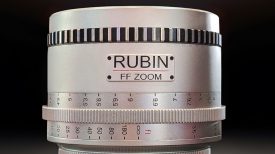Canon has just announced the XF705 camcorder. The XF705 is the companies flagship model in the XF series and can shoot 4K UHD 50P in full 4:2:2 10-bit. Perhaps the cameras biggest drawcard is actually its new XF-HEVC codec.
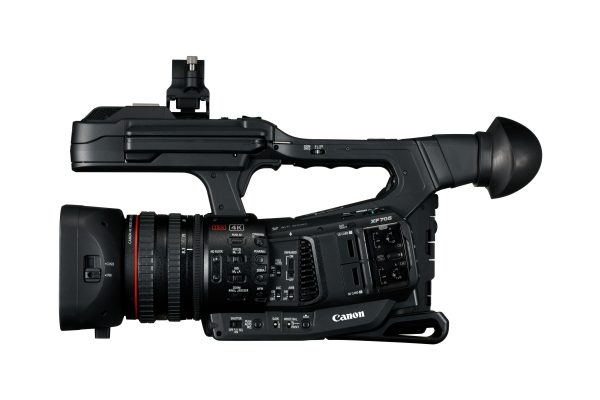
The XF705 uses a 1.0″ type CMOS sensor and DIGIC DV6 processing. This is the same image processor that can be found in the C200. The recently announced EOS R uses a Digic 8. The camera is equipped with a fixed 15x optical zoom, and a maximum aperture of f/2.8. The aperture on this lens is not fixed though and changes between f/2.8-4.5 depending on your focal length. At the wide end, the lens can work at 25.5mm and it also utilizes built-in IS which is important when shooting handheld. The lens has three independent control rings for iris, focus, and zoom, all with end stops.
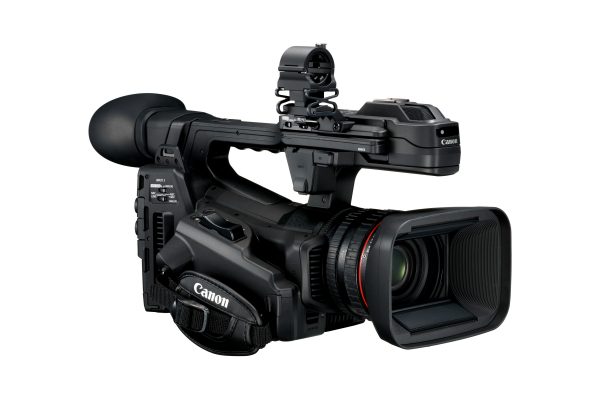
The XF705 is capable of recording HDR files internally using both the Hybrid Log Gamma (HLG) and Perceptual Quantisation (PQ) HDR formats. The camcorder also has HDR assist functions to support the user when controlling exposure. The XF705 can also output an SDR signal at the same time as recording an HDR file internally to an SD card. The XF705 has a 12G-SDI interface, which allows for an uncompressed UHD 50P signal to be sent over a single SDI cable. The camera can also stream 4K UHD HDR using the HEVC format via the network. This makes it ideal for broadcast and video production applications, for users who want capture 4K UHD HDR video, but still want to have a streamlined production workflow.
XF-HEVC codec
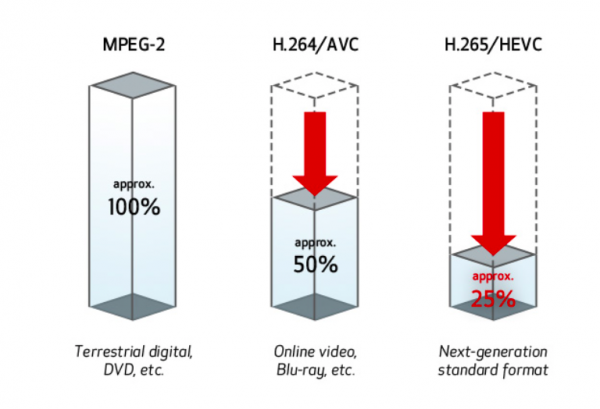
If there wasn’t already enough codecs floating around, Canon has introduced another one. The new XF-HEVC file format utilizes HEVC encoding technology that is about twice as efficient as mainstream H.264/AVC. By using XF-HEVC the XF705 can record 4K UHD 50P 4:2:2 10-bit files directly to widely available SD cards. The way this works is Canon is using (HEVC) video compression, and then packaging it inside the industry standard Material eXchange Format (MXF) container. This is a big deal as one of the primary concerns when capturing 4K material is the amount of data it takes up and the price of the recording media. Leveraging HEVC encoding technology and putting it inside a camcorder like this makes a lot of sense. All of the major NLE and post-production software will be supporting XF-HEVC, including Adobe, Avid, FCPX, and Blackmagic.
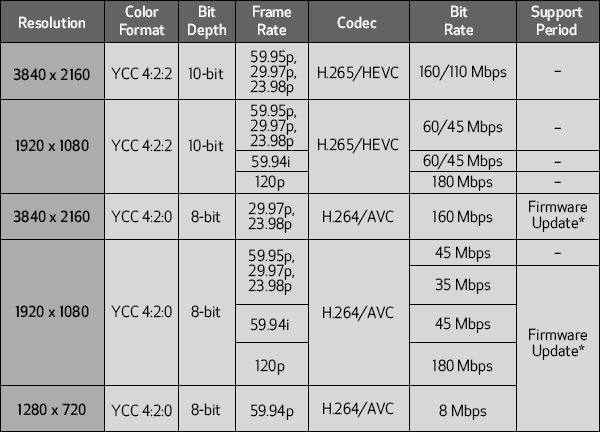
* These recording formats will be available in a coming firmware update on a date to be determined.
Considering Canon has been able to put XF-HEVC recording into the XF705, it is a little bit of a surprise that this codec wasn’t used in the EOS R, or even the C200. The fact that a camcorder gets 4K UHD 50P 4:2:2 10-bit internal recording and the Canon C200 doesn’t is a bit of a head-scratcher.
Dual SD Card Slots
Dual SD card slots allow for simultaneous or relay recording. Simultaneous recording allows you to record on both SD cards at the same time, so that you can use one as a backup. Relay recording allows uninterrupted recording from one card to the other when the first memory card becomes full.
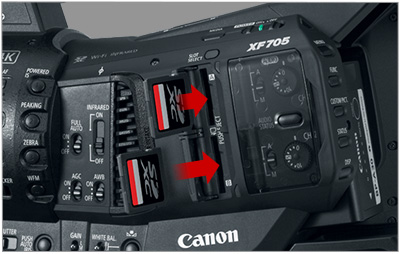
5-axis Optical Image Stabilization (IS) system
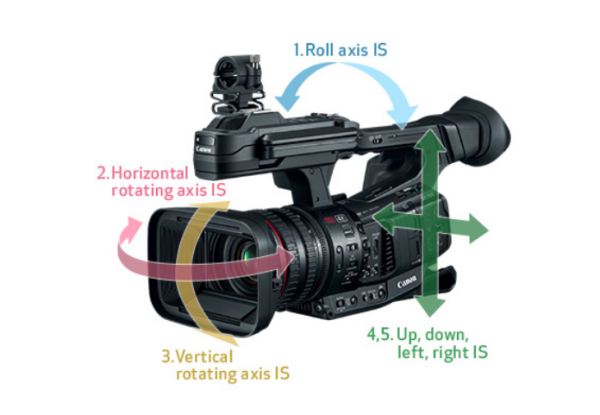
The XF705 camcorder has a 5-axis Optical Image Stabilization (IS) system, featuring three modes of image stabilization: Standard, Dynamic and Powered. In Standard IS mode, the stabilizing angle is made constant, independent of the zoom magnification. Dynamic IS mode extends the stabilizing range at the wide end of the focal length, allowing for image stabilization when shooting while walking. Powered IS mode helps facilitate stabilization in the low frequency range at the tele end, and should be used exclusively for fixed-point shooting which does not involve panning.
Other features
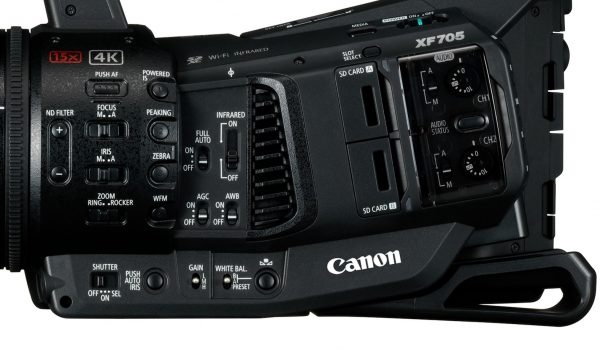
The XF705 has a built-in Infrared mode, ND filters, manual white balance modes, zebras, peaking, waveform, dual SD card slots, wi-fi, infrared control, and a host of manual and auto shooting options. The camera can also shoot at frame rates of up to 120p in HD.
Dual Pixel CMOS AF
Canon has also given the XF705 Dual Pixel CMOS AF. This is the same system used in the C100 Mark II, C200, C300 Mark II, and the recently announced EOS R. Dual Pixel CMOS AF is an accurate and fast way of doing autofocus with touch focus control, Face Detection AF and object tracking. The Dual Pixel Focus Guide also provides a graphical guide to support accurate focusing when manually adjusting the focus. This is the same guide as used in the C300 Mark II, C200 and EOS R.
Canon Log 3
Canon Log 3 shooting can be especially effective for documentaries and other settings with drastic changes, along with outdoor and other locations where light conditions change frequently, or where monitoring setups may be insufficient.
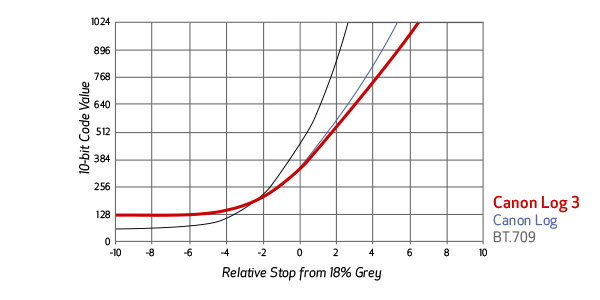
HDMI 2.0 Terminal with 4K UHD 60p Output Support


** Internal recording not enabled.
*** Restrictions apply only when shooting in 4K UHD 60P. OSD overlay disabled / Browser remote Live View disabled.
Live IP Streaming
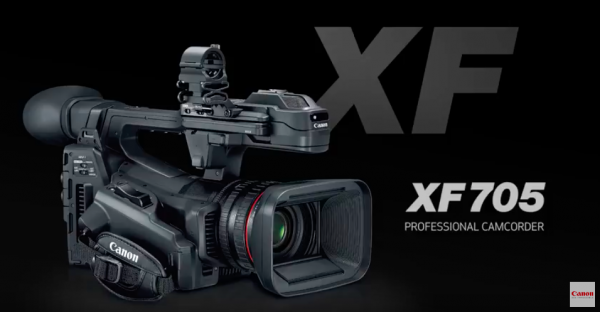
The livestream can be viewed directly from the camcorder using the on-board LCD monitor, sent to a standalone HEVC IP encoder or redirected to a 4K UHD monitor for a confidence check and public viewing. In addition, Live HDR data (Message/Mastering Display Color Volume) can be added in the H.265 stream if required to help improve picture quality.
Network Connections for FTP Transfer and Browser Remote (Wired and Wi-Fi® Connectivity)
The camera can also be accessed remotely from a typical web browser running on a laptop or a compatible smart device to control functions such as record start/stop, record mode and frame rate, AF/MF switching, focus/zoom settings and white balance mode*. Background transfer of video files via FTP links is also possible, enabling the latest news images, for example, to be distributed quickly over the Internet.
* Compatible with iOS® versions 9/10, Android™ smartphone and tablet versions 4.4/5.0/5.1/6.0.
Optional Wide and Tele Accessories
There is an optional Wide Attachment WA-U58 and the Tele Converter TL-U58 attachments available for the XF705.
The Wide Attachment WA-U58 offers a 0.8x wider angle of view, and the tele Converter TL-U58 provides extended 1.5x longer telephoto range for the XF705 camcorder’s fixed lens.
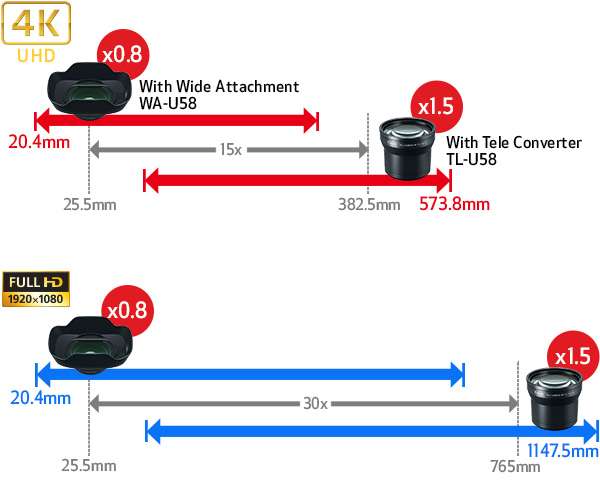
Are small sensor cameras still relevant?
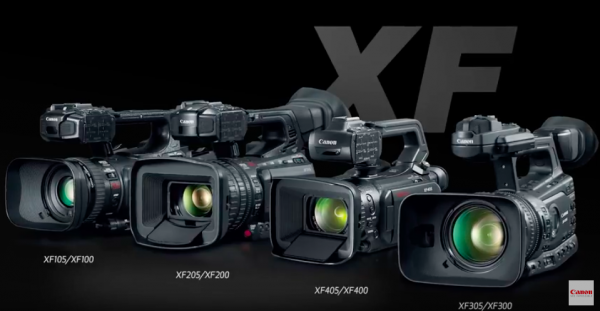
Canon’s original XL-1 was released way back in 1997. It was designed for the prosumer market and became very popular with independent filmmakers at the time. The XL-1 had a 3CCD chip, XLR inputs, interchangeable lenses, and even a viewfinder. Since that time Canon has released a multitude of cameras under the XF name. Today the XF series consists of the XF100/105, XF200/205, XF300/305, XF400/405 and now the XF705. All of Canon’s XF series camcorders feature Neutral Density filters, vectorscope, waveform monitor, focus assist, 2-channel 16-bit 48 kHz audio recording, two XLR audio input jacks, HDMI output, headphone jack, USB Mini-B, LANC remote jack, built-in stereo microphone, and two primary flash card slots for dual recording or relay recording.
Competition
Sony has the 4K 4:2:2 10-bit PXW-Z280 and PXW-Z190 camcorders, although they use the smaller 1/2″-type Exmor R CMOS image sensor, and 1/3″-type CMOS sensors respectively. To go to a 1″ sensor, Sony has the PXW-Z150, but it can only record 4K UHD XAVC Long GOP in 4:2:0/ 8bit 100 Mbps. It can, however, do up to 120p in HD. Panasonic has the 1″ HC-X1, and JVC also just released their new 1″ GY-HC500 and Gy-HC550 Connected cams that can shoot in 10-bit ProRes 422 at 4K resolution up to 50/60p.
Specifications
Standard Definition or High Definition
Power Supply (rated)
Video Recording system
Color Sampling: 4:2:2 (10-bit) or 4:2:0 (8-bit)
File Format: MXF
Recording Modes:
XF-HEVC 160 Mbps/110 Mbps: 3840×2160 (60p/30p/24p)
XF-HEVC 60 Mbps/45Mbps: 1920×1080 (60p/30p/24p)
XF-AVC 45 Mbps: 1920×1080 (60p/30p/24p)
Audio Recording system
Image Sensor
Total Pixels
Effective Pixels
Maximum recording Time
160 Mbps: 25 min.
110 Mbps: 35 min.
60 Mbps: 65 min.
45 Mbps: 90 min.64GB card
160 Mbps: 50 min.
110 Mbps: 75 min.
60 Mbps: 140 min.
45 Mbps: 185 min.128GB card
160 Mbps: 105 min.
110 Mbps: 150 min.
60 Mbps: 280 min.
45 Mbps: 375 min.256GB card
160 Mbps: 210 min.
110 Mbps: 305 min.
60 Mbps: 565 min.
45 Mbps: 755 min.A variable bit rate is applicable in each case.
Lens
Focusing System
The detection range for CMOS AF is approx. 80% (vertical) x 80% (horizontal) of the entire field of view.
Manual Exposure
Max Shutter Speed
Minimum Focusing Distance
White Balance
Frame Rate
Minimum Illumination
Low Light Mode: Approx. 0.1 lux (shutter speed: 1/2 sec.)
Genlock Terminal
Timecode Terminals
Image Stabilization
(Image rotation and camcorder movements in the yaw and pitch directions are electronically corrected.)
Modes: Dynamic IS, Powered IS, Standard IS, IS Off
Filter Diameter
Viewfinder
LCD Screen
Microphone
Recording Media
USB Terminal
Video Terminal
Audio Terminal
HDMI Terminal
AV Mini Terminal/Headphone Terminal
Operating Temperature range
For Operation: Approx. -5-45° C, 60% (relative humidity)
Dimensions
Approx. 7.5 x 10.2 x 17.0 in. / 191 x 258 x 433mm (including lens hood, eyecup and mic holder unit)
Weight
Price and availability
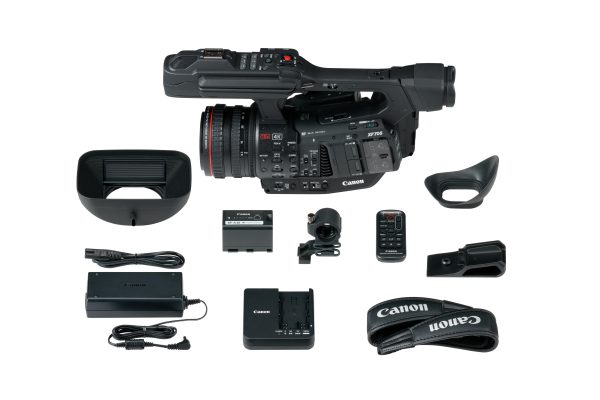
The Canon XF705 isn’t exactly cheap. In Europe, it will retail for €6999 incl. VAT. In the US it is $6999 USD. The camera will be available for purchase in December.





